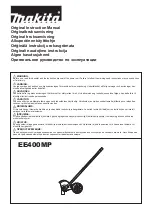
Read Before Using
Now You are Ready to Spread
• Spread header strips at the ends of the area OPPOSITE the direction of
spreading. This will provide a “turn-around” area, an area to re-align the
spreader for the return spread.
• Example is for 6 ft. wide spread: Make the first
spreading pass at one-half the spread width from
the edge of the spreading area or in this case
approximately 3 feet or one big step.
• Additional spreading passes will be at the full spread
width or approximately 6 feet apart.
• TAKE A SIGHTING AT THE FAR END. Keep your eye
on the sighting as you spread. You will not need to
wonder where you are or where you have been.
Continue until spreading is completed.
• Left over fertilizer can be spread under trees and other high feeding
areas without showing “edge of spread” lines.
NOTE: With the rotary agitator installed, the rate gate closed (not spreading) and with material in
the hopper, the spreader will push harder than normal. (This is because the agitator is stirring the
material and it has no place to go.)
RECOMMENDATION: When not spreading and the spreader is being pushed some
distance, tip the spreader so only the idle wheel is on the ground.
Header
Header
6’
3’
6’
6
Operating Instructions
How to Use the Spreader
1.
Set swath adjustment to calibrated setting.
2.
Set spread rate adjustment nut to calibrated rate.
3.
Close hopper and fill with material.
4.
Go to place where you wish to begin spreading.
5.
Turn delivery crank to start spinner.
6.
Pull flow lever forward to start flow of material and begin walking.
The lever will lock automatically in preset delivery rate position.
7.
To stop material flow, push down on the hopper release lever.
How to Clean the Spreader
1.
After use, empty the hopper and give the crank a few turns for fur-
ther cleaning.
2.
Rinse with hose and water.
2.
Dry thoroughly and oil visible moving parts.
Broadcast Spreading
Broadcast spreading
is as old as early man.
In the early days of
agriculture, field seed-
ing was accomplished
with hand cast broad-
casting. The hand
cast method of seed-
ing was a limited fac-
tor in growing field
crops that were hand
seeded.
Mechanized casting
came into being in
1868 when Samuel
Speicher invented the
Hand Crank "Cyclone"
Seeder.
The seed sower was a
breakthrough in field
seeding. It was hailed
as a major advance-
ment in agricultural
implements.
Paul Speicher put the
hand crank seeder on
wheels in 1955.
This development ush-
ered in a new era in
spreading and spread-
ing products. New
products and product
forms adapted to
broadcast spreading
were developed.
In 1988 a new dimen-
sion was added to
broadcast spreading -
SPREAD PATTERN
CONTROL - a dead
center spread pattern
equalizer.
Spyker's Accuway
®
spread pattern equal-
izer solves a compli-
cated problem with a
fundamental patented
solution.
7
1 YEAR LIMITED WARRANTY
This is warranted to the original purchaser only, other than used commercial-
ly, against defects in materials and workmanship, for a period of one year from
the date of purchase.
*For Spyker Spreaders LLC,
products employing metal gear
systems, pinion and bevel, these metal gears, only, not inclusive of any other
parts or materials, are warranted for the life of the spreader, not to be used for
replacement or repair past original purchase.
Spyker Spreaders LLC will not be liable for any loss, damage
or expense including,
but not limited to,
consequential or
incidental damages, arising from the operation, condition or use of the item.
The sole and exclusive remedy against Spyker Spreaders LLC being the
replacement of the defective parts. This warranty gives you specific legal
rights, and you may also have other rights which vary from state to state.
THIS EXPRESS WARRANTY, WHICH IS APPLICABLE ONLY TO THE ORIGINAL
PURCHASE, IS IN LIEU OF AND EXCLUDES ALL OTHER WARRANTIES,
WHETHER EXPRESSED OR IMPLIED BY OPERATION OF LAW OR OTHER-
WISE, INCLUDING ANY WARRANTY OF MERCHANTABILITY OR FITNESS
FOR PARTICULAR PURPOSE.
SPYKER SPREADERS LL
C
P.O. Box 7 • Urbana, IN 46990 USA






















